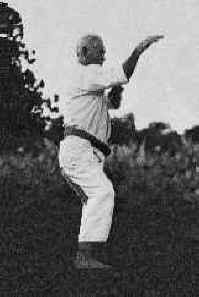 Hohan Soken performs Passai Dai |
Passai
 Hohan Soken performs Passai Dai |
Meaning: This kata means “to breach a fortress” or “to penetrate a fortress”.
History: Due to this name many people believe that this kata was developed to teach students how to fight against any attack or any defense. There are two major versions of this kata; Passai Sho (Passai Minor) and Passai Dai (Passai Major). Passai originally came from China. It is heavily influenced by the crane system. The creation of this kata is once again disputed. The credit for Passai Dai goes to Bushi Matsumura as being either the creator, or the person who brought it back to Okinawa from China. However the creation of Passai Sho is credited to either Bushi Matsumura of Itosu. Most authors give credit to Itosu. The Sho version of this kata has been called the “meditation” version of the kata. Passai has been one of the most favored kata in history. This is very apparent by the number of versions of this form, fifteen in total.
|
|
|
Justin Hayes Performing Ichi Gina Pai Sai |
1. Matsumura Passai, named after Bushi Matsumura
2. Matsumora Passai, named after Kosaku Matsumora
3. Odadomari Passai, named for Peichin Oyadomari
4. Itosu Passai, named for Yasutsune Itosu
5. Funakoshi Passai (Bassai), developed by Gichin Funakoshi
6. Kyan Passai, named for Chotoku Kyan
7. Ishinime Passai, named after Ishimine
8. Tawada Passai, named after Tawada
9. Tomari Passai, named after the village
10. Ichigina Passai, performed with Getas
11. Shimpaku Passai, named after Motohiro Shimpaku
12. Ishiro Passai
13. Teruya Passai
14. Anzato Passai
15. Oshiro Passai
The older versions of this kata perform the beginning T-stance with the left leg
in front exposing the calf muscle to an attack. With the introduction of western
type show to Okinawa, many masters changed this beginning to placing the left
leg behind the right leg. Therefore the shin of the right leg would have been
kicked if attacked not the calf of the left leg. The Japanese version of this
kata is called “Bassai”.
|
|
|
Justin Hayes Running Bai Sai Dai |
What to Get Out of This Kata: Students will learn many things from this kata. It teaches how to fight at night or when one has lost the ability to see for some reason or another. This kata teaches how to trap an opponents attack and quickly counter that attack. This kata teaches great weight movement or body shifting. It has been said that the opening movements of this kata are used to teach a student how to hide hair pin in their right hand, which they will later attack with. The Ichigina version of the kata can be used to teach students two different things. First it will teach students many open hand techniques and trapping of any opponents kick with a break of the foot. Second this kata can be ran with Getas (sandal type shoes) which will teach the student how to defend with the use of Getas.
